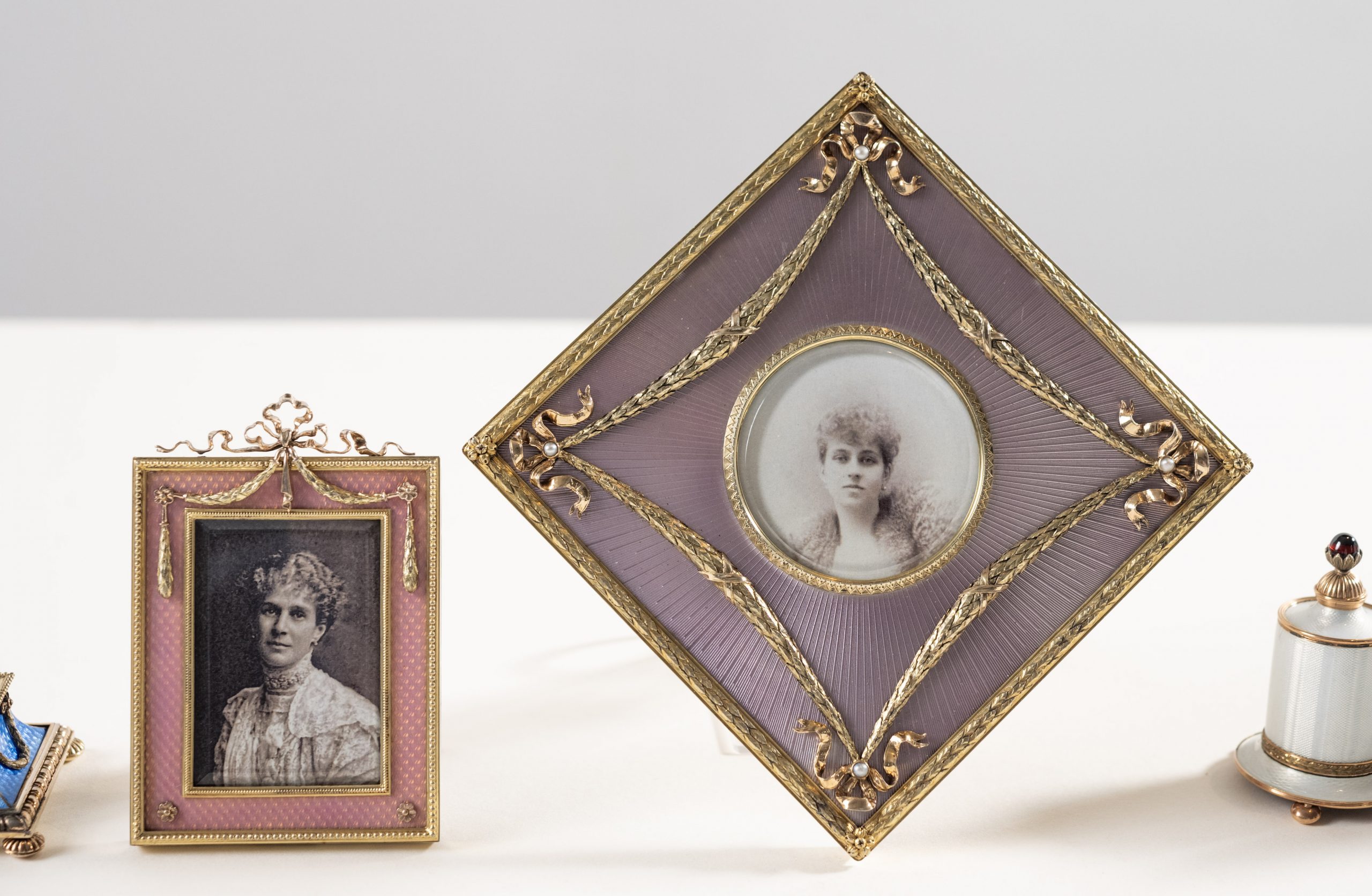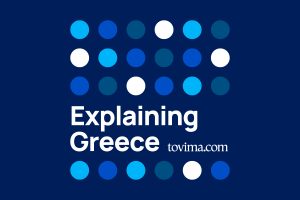This sign stood next to a display case in the Brighton Museum Art Gallery containing five exquisite Fabergé objects, including two picture frames with images of elegantly dressed women in furs, lace, diamonds, and pearls. Their identities, however, had long remained a mystery to researchers.
A gold-mounted photograph frame in translucent purple enamel, a smaller but equally beautiful frame in rose pompadour enamel, two gum pots—one with a moonstone finial and another adorned with a garnet—and a striking blue stamp damper were put on display after more than 90 years in storage at the Museum.
The sign caught the attention of Andreane Rellou and her sister as they admired the exhibits during their visit to the Edward Burne-Jones exhibition in March 2024.
The Fabergé Mystery
“Why don’t you give it a shot?” Andreane’s sister challenged her.
Rellou, a Greek London-based actress, screenwriter and activist in her twenties, who is also a mystery aficionado, decided to take on the challenge and solve the mystery surrounding the identity of the two ladies which had eluded the specialists for so long.
Everything began in 2019 when Geoffrey Munn, the renowned fine jewelry expert from the BBC’s Antiques Roadshow, discovered five rare Fabergé items during a meeting with the Brighton & Hove Museums Fashion curator, Martin Pel. Munn noticed the corner of one of the two frames poking out of its archival tissue in the museum storeroom.
Before arriving in the storeroom at the Brighton Museum, the objects had come to light at Preston Manor, an Edwardian estate in Brighton once owned by Dame Ellen Thomas-Stanford, a wealthy heiress and friend of Queen Victoria who may have received the frames as gifts. Although Munn speculated that the women depicted could well have had a royal connection, the two key mysteries—how the items arrived at Preston Manor and who the women portrayed were—remained unresolved.
‘Absolutely Fabergé’
Despite its patina of tobacco smoke and lamp oil, Geoffrey immediately recognized the piece as having been crafted in Russia under the supervision of Carl Fabergé, the famous court jeweler to the Romanov tsars.
“Why did it catch my eye? For me, it’s no more complicated than finding your own car in the car park or recognizing your own handwriting. I’ve spent my life surrounded by Fabergé and so I recognized it immediately,” said Munn.
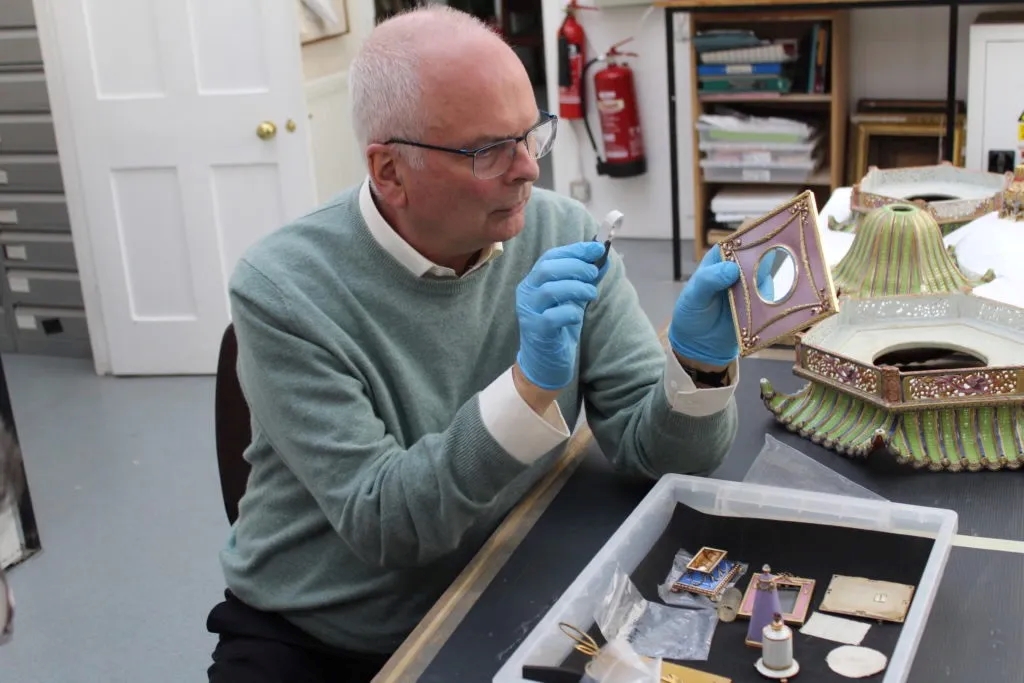
Antiques expert Geoffrey Munn examining the disassembled lilac Fabergé photograph frame Courtesy of Brighton &Hove Museums
The presence of the Russian imperial warrant, a double-headed eagle which was often used alongside the Fabergé signature to indicate that the famed jeweler was retained by the Tsar himself, confirmed Munn’s suspicions.
‘I think I’ve solved the Fabergé Mystery’
The day after Andreane’s visit, Brighton Museum’s inbox received an email from her proposing an identity for the woman in the first portrait. Thanks to her passion for mysteries and fashion history, the young amateur detective had solved the first mystery just four hours after her visit to the Museum.
“I took a methodical approach,” Rellou explains to To Vima English Edition. She guessed that the older of the two women—seen in the square frame—was most likely in her early 40s. After researching and comparing photographs of hairstyles and fashion, Rellou concluded that the photo must have been taken during the early Edwardian period (1901-1919), leading her to surmise that the woman was born in the 1860s and likely married in the 1880s.
Given that the high cost of Fabergé frames clearly meant a wealthy owner, Rellou researched high-profile weddings of the 1880s. This led her to Marie de Rothschild, wife to Leopold de Rothschild, one of the wealthiest men of that era.
“Uncovering the second woman, in the larger frame, took a lot more time,” says Andreane, who employed forensic techniques she found online in her research. But, though untangling the second identity proved harder, Andreane explains, “I was lucky because, being a native Greek speaker, I was able to explore Greek-language archival material and newspapers which hadn’t been available to earlier researchers.” After comparing photos of royalty and the upper classes, Rellou was able to confirm a couple of days later that the second woman was none other than Sophia of Prussia, Queen of Greece from 1913-1917 and one of Queen Victoria’s granddaughters.
“We are thrilled with Andreane’s discovery. We tried for many years to discover the women’s identities, but she cracked it by researching European aristocracy. We’re extremely happy to have the mystery solved at last,” said the Creative Programmer for the Brighton & Hove Museums, Paula Wrightson.
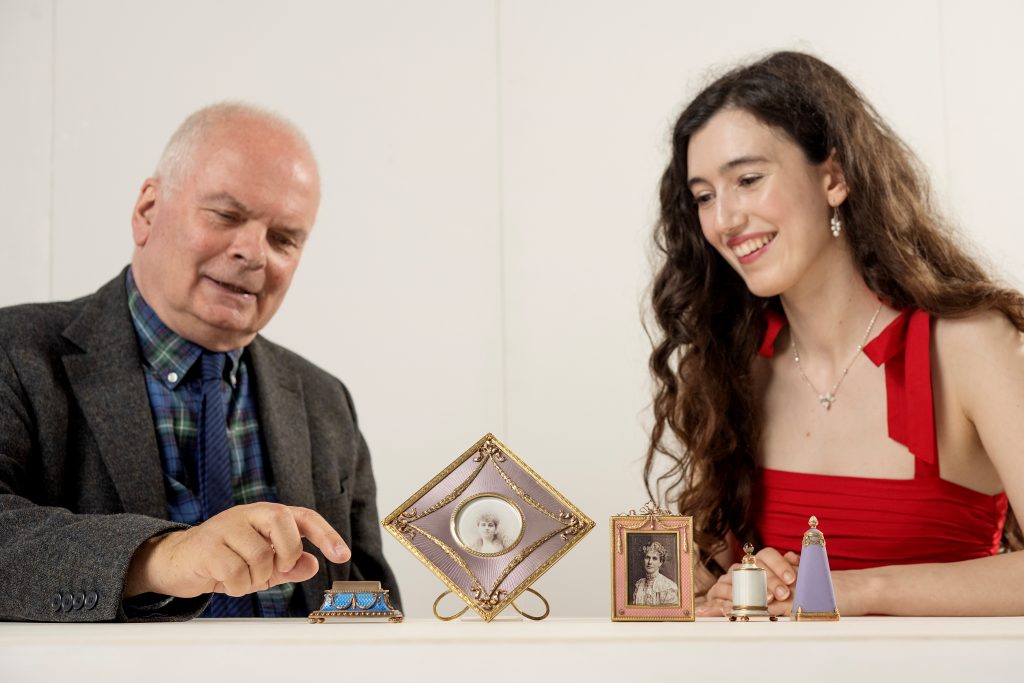
More than Sleuthing: a True Calling
While specialists struggled to identify the women in the portraits and ended up seeking the public’s help, this curious visitor was proud to solve the mystery in a matter of days. When asked about the key elements that made this successful and exciting discovery possible, Rellou described herself as a “period enthusiast” with a passion for the books, fashion and films of specific eras. She also mentioned her pattern recognition skills and eye for detail. However, the young actress explained that she had not been the stereotypical high-achieving student at school, which is why she considers her success at cracking the Fabergé mystery to be one of the most validating experiences of her life. As she put it: “A happy life is about leaning into your passions, following your curiosities, and accepting your unique gifts.”
Apart from finding her true self, Rellou says another motivation for undergoing detective work is to unearth women’s achievements which have been forgotten by history—a theme she frequently returns to in her screenplays.
“I was struck by the idea that these women’s identities were lost, and I immediately felt compelled to look into it,” she told To Vima English Edition. “I find it disappointing that we only remember women for who they were married to, rather than for their achievements and personalities. These women deserve to be remembered, and I’m very happy that their names will now be heard and spoken again.”
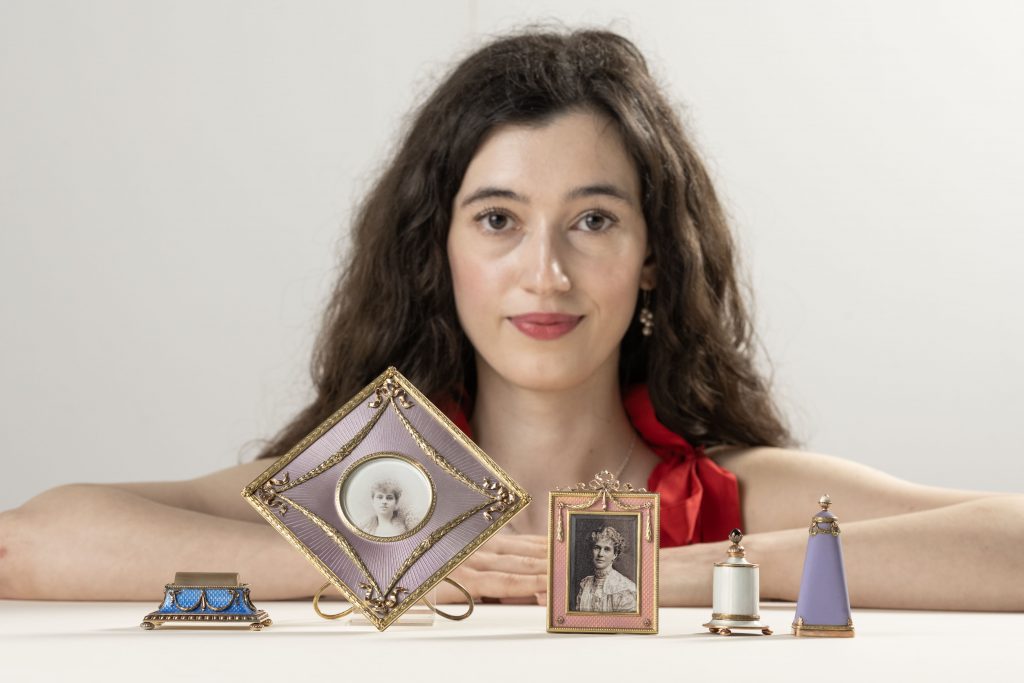
ZacharyCulpin/BNPS
Andreane Rellou’s BIO:
Andreane Rellou is an actress and screenwriter, originally from Athens, Greece, and based in London. She initially trained at the Performing Arts High School of Athens, and then moved to the UK to study Music at the University of York. Following that, she gained an MA in Acting from East 15 Acting School. In 2023, she wrote and acted in the award-winning short film ‘Sorry I’m Late’ directed by Kat Sigalas, which was presented through the ADHD Hellas Foundation.
Apart from her work as an actress, she’s also a screenwriter. Currently, she is developing a TV series called ‘The Three Graces’ – it’s about three Greek female artists and models (Maria Zambaco, Marie Spartali-Stillman and Aglaia Ionides) who lived in Victorian London, and who greatly influenced the Pre-Raphaelite Brotherhood. Their work, and their names, are unfortunately mostly forgotten, but for the past two and a half years, Rellou has been utterly fascinated with the idea of telling their story. She has done quite significant detective work in finding out more about them, and much like with the Fabergè discovery, she is very excited to be bringing the stories of these women into the spotlight.
